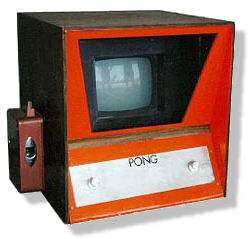|
|
 |
|
|
home site news atari news atari glossary > 0...9 > a...f > g...m > n...s > t...z > atari v.i.p. atari history atari video game systems atari computers atari coin-op atari stand-alone-systems atari library atari theater atari links legal stuff/imprint contact us |
Atari Glossary 'n...s' PAM 'PAM' was the nickname for Atari's 5200 console. The 5200 almost became named P.A.M. (Personal Arcade Machine). PANTHER In the late 80s, Atari was thinking about a new video-game-system with enhanced capabilities. They began to develop a new-generation 32bit video-game-system, code-named 'Panther'. The system never came to life, because the 64bit 'Jaguar' took its place. PBI The 'PBI' (Parallel Bus Interface) could expand the 'XE' series of computers with expansion devices such as the Atari 1064 64k memory module and the Atari 1090XL Expansion System. Later on the 'PBI' became the 'ECI' on Atari's XL-series. PIA PONG Atari's
first game ever; Bushnell is generally believed to be the author of PONG.
Actually, Magnavox released the ODYSSEY 100, the first home video game system,
which included a game remarkably similar to PONG, several months before PONG's
debut in the arcades in 1972. It's as simple as that: 'Avoid missing ball for Highscore'!
PROTOTYPE A piece of hardware / software in its development stage. A lot of prototypes never made it to the market, especially at Atari. Atari was kind of a master of prototypes. POKEY Digital I/O chip. Handles the serial I/O bus ('SIO'), audio generation, keyboard scan, and random number generation. Also digitizes the resistive paddle inputs and controls maskable interrupt (IRQ) requests from peripherals. SIO Serial I/O bus for external, serial communication. Handled by 'POKEY'. SLAM-PAM An add-on for the Atari 5200 that would have provided full 7800 compatibility for this machine. ST (SIXTEEN / THIRTYTWO) Atari's 16bit computer-line. The expression 'ST' refers to the processor's (Motorola 68k) bus architecture; 16bit external and 32bit internal addressing. STELLA The nickname for the Atari 'VCS' (2600) in its development-stage. Developed by Joe Decuir, Ron Milner and Steve Meyer. The project was supervised by Jay Miner. SYZYGY Syzygy: sun, moon and earth in total eclipse. This was thought to be the name for the company we know as 'Atari' today. But the name was already owned by a roof-tiling company. Nolan Bushnell and Ted Dabney decided to name the new company 'ATARI' (a word from the japanese game 'GO', meaning something like 'check' in chess) and give it the well-known 'FUJI'-symbol (from the japanese mountain 'Fujijama') as its logo.
On the
left you see the first 'Syzygy' logo - obviously a tribute to the game
'GO' (black and white stones). |
|
|
Contents and pictures © 1999 - 2026 by 'www.atarihistory.de' unless otherwise noticed |



